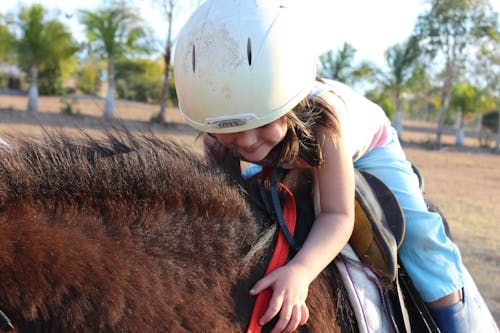
An emergency dismount can help save your life. It is an option a rider has when a horse is either out of control or has ignored the commands of its rider in order to flee. This type of dismount can be used if the rider fears for their own safety or if the horse has lost its bridle or saddle.
The Steps to an Emergency Dismount
To start off you will need to practice in an arena – preferably a smaller sized arena or a round pen. You will need good footing, a helmet, and you absolutely have to have another person with you.
Start at a walk or a halt. The first few times you attempt an emergency dismount your horse might be startled. If they become too frightened you can simply let them go and your instructor or dismount assistant can help you catch them.
An instructor or helper can also lunge or lead your horse for the emergency dismount. They need to lunge/lead from the opposite side of the dismount so no one gets hit or tangled. The assistant can lead the horse in a straight line while the rider practices their emergency dismount. The assistant can increase speed to a trot or a canter (while lunging) once the rider has mastered the moving dismount at a walk.
To start an emergency dismount take both feet out of the stirrups. A safe and successful emergency dismount depends on both feet being out and free of the stirrups. Removing your feet helps prevent the rider from getting their foot stuck or tangled in their stirrup(s). This is the most important step!
Related Content:
Fear of the Fall: How to Regain Your Confidence Horseback Riding
Horse Behavior 101
The reins can be tied in a knot and placed up the horse’s neck so they don’t get caught by your arms or legs or have a horse flip loose reins over its head which can create a tripping hazard.
Put both hands on your horses neck and lean forward and swing your legs back it out behind you like you are pretending to be a vaulter. You should lean on to your stomach and the weight should be on your hands placed either on the saddle or on the horse’s withers.
Kick your feet up behind you to create backward momentum. Kicking your legs out behind you and over the horse will help you stay away from the stirrups so you don’t get tangled.
NOTE** If you have a person that can lunge or lead you, you can put the stirrups up and practice without them first.
Once your feet are up and over the horse, land on your feet on the side of the horse. Make sure to bend your knees to absorb some of impact if you have bad knees or if you land hard. You want to land in the direction of travel.
Forward Momentum and Gravity
The rider can also can tuck and roll or run a few steps in the direction of travel as you land. This is useful at higher speeds such as the canter/gallop when there will be much more momentum the rider will have to absorb during the landing.
If you decide to roll because of the impact take note of what direction you have dismounted from your horse and will try to roll away from your horse. Tuck your chin to your chest and wrap your arms around your legs and somersault away from the animal.
Practicing this thought process NOW will hep train your brain to recognize that you need to tuck, roll, do an emergency dismount, etc. to get you safely off the horse in an emergency.
Always practice starting at a halt and with assistance. Always wear a helmet when practicing! An emergency dismount is an excellent tool every rider should utilize as part of their basic riding skills and training. Be safe and enjoy the ride 💙
https://www.youtube.com/watch?v=XqTIcFbiWnY